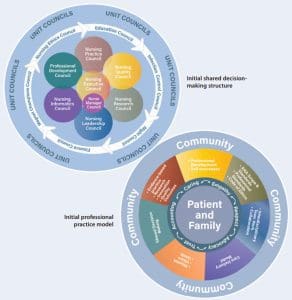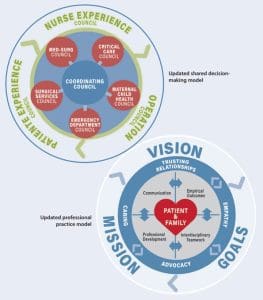Lessons learned from three site visits.
Takeaways:
- Although an organization may be familiar with Magnet process, the standards for redesignation increase because the American Nurses Credentialing Center continues to raise the bar with each new Magnet manual.
- When attaining the first designation, an organization cultivates a Magnet culture, structure, and foundation through staff engagement.
- By the second and third redesignations, an organization refines this structure and improves its processes and outcomes.
- The key to sustaining a Magnet organization is to keep the Magnet culture alive consistently.
Organizations that receive American Nurses Credentialing Center (ANCC) Magnet® designation epitomize nursing excellence in patient care. White Plains Hospital (WPH), in White Plains, New York, achieved its first ANCC Magnet designation in 2012 and was redesignated in 2016 and 2021. Metaphorically speaking, earning our second designation was comparable to a parent adjusting to their second child—approaches that worked well with the first child don’t necessarily work with the second. We had the structure and foundation in place from the first designation, but we needed to adapt and re-establish some of our processes. We also identified opportunities for improvement in nursing care and research. Our journey to our third redesignation was a smoother transition because we were better acquainted with the process. Like seasoned parents having their third child, we already knew the drill.
2012: First Magnet designation
In January 2008, the WPH board of directors, chief executive officer, organizational support, chief nursing officer (CNO), and Magnet program director (MPD) initiated our Magnet journey with a strategic plan to advance nursing practice and patient outcomes. A 2008 gap analysis showed that we needed to create a shared decision-making model (SDM), define our professional practice model (PPM), and improve our empirical outcomes. With the collaboration of our nursing leadership team and clinical nurses, we created a shared governance model, a PPM, and a foundation for evidence-based practice. (See Building shared governance and professional practice.)
Building shared governance and professional practice
Shared governance helps organizations improve working conditions and empowers nurses to make decisions to enhance practice and patient care. Professional practice models (PPMs) serve as theoretical frameworks—predicated on shared governance, an organization’s core values, healing, relationships, and patient-centered care—to guide nursing practice.
The White Plains Hospital (WPH) relationship-based PPM combines two theories—Jane Sumner’s Caring Theory and Patricia Benner’s Novice-to-Expert Theory. The original WPH circular model incorporates the hospital’s mission, vision, and goals. It relies on, builds upon, and reverts to each while keeping patients at the center. WPH nurses integrate patient and family knowledge, values, beliefs, and cultural backgrounds into care planning and delivery


We learned a great deal while preparing for our first Magnet document submission in 2011. Led by our MPD, we built new structures and processes, educated staff about changes, and enculturated them into our organization. Once the document was accepted and revisions complete, the MPD and nursing leadership team shared it with each unit. They prepared the nurses and role-played potential questions the appraiser might ask.
During the 3-day site visit, appraisers interviewed staff to validate information provided in the submitted document and to understand how each unit’s specific goals and outcomes align with the organization. Ahead of the visit, staff members were notified that they were invited to breakfast and lunch sessions with the surveyors. Because this was our first visit, discussion focused on organizational culture, our SDM, and how we operationalize our PPM.
In April 2012, we gathered in the auditorium with hundreds of WPH staff members and leadership anticipating a live conference call with ANCC. WPH received its first designation as a Magnet organization.
2016: Second Magnet designation
As we prepared for our second Magnet designation, we knew what to expect and were familiar with the elements of the Magnet model. Staff could articulate what Magnet designation means for nursing practice and the organization.
Unlike the first designation, we already had structures and processes in place; however, we discovered that they weren’t hardwired. We were surprised when our nurse engagement survey showed a significant drop in engagement metrics and SDM participation. Lost focus took a toll on our structures and outcomes. We needed to get back on track and re-engage nurses. In 2014, with CNO support, the nursing division hired a consultant to help us re-evaluate and redesign our SDM model. Based on their advice and to align with a model that was fully inclusive of shared decision-making, we restructured our shared governance and PPM. (See Restructuring for inclusivity.)
Restructuring for inclusivity
In preparation for White Plains Hospital’s second Magnet designation, the organization restructured its shared decision-making and professional practice models to ensure inclusive shared decision-making.


Streamlined processes
The new SDM streamlined the decision-making process and provided an avenue for all nurses at all levels to have input. Redesigned as a two-tiered council structure, the model includes four central councils at the systems level, representing the entire nursing division. Five councils sit at the service line level within the nursing division, culminating in a central council. The new model provides better coordination and integration of all council work and creates opportunities for nursing staff involvement, even for those who aren’t on the council. The council makes decisions after reviewing feedback from all nursing colleagues.
Through collaboration with the information technology (IT) department, we created an electronic-based communication system to record all council minutes, projects, and requests for feedback and participation. All decisions generated from our redesigned shared governance structure align with our organization’s strategic planning, mission, vision, values, and goals.
Site visit
During our 2016 Magnet site visit, we impressed the appraisers with our PPM, nursing staff engagement, and dedication to the councils. We received exemplar recognitions for our holistic care program and integrative holistic therapies (healing touch, reiki, and aromatherapy) for managing patient pain, sleep deprivation, insomnia, anxiety, and distress. This program complements conventional medical care, leverages our autonomy via nurse-driven care consults, and demonstrates nursing’s collaboration with the pain management team. Postintervention data of the holistic care program revealed a 13.3% improvement in our Hospital Consumer Assessment of Healthcare Providers and Systems pain score.
We also received constructive feedback from the Magnet appraisers. Although we demonstrated good outcomes, we didn’t share our best practices externally. We had a foundation for research but needed to focus on advancing nursing science and knowledge. We made conducting research and publishing our outcomes in peer-reviewed journals our primary aims for our third designation.
On November 22, 2016, WPH received its second designation as a Magnet organization.
2021: Third Magnet designation
We entered our third designation with an ingrained Magnet culture. We needed less time to prepare the nursing staff, and we knew what to expect, what documents to prepare, and who needed to participate in each session. However, we still experienced uncertainty. How engaged will the staff be? Will the third round be more rigorous than the others? Are we all ready?
Responding to feedback
To address feedback received at the previous site visit, we evolved WPH evidence-based practice (EBP) and nursing research development program to ensure it aligns with Magnet Model Component IV (new knowledge, innovation, and improvements) as well as standard 13 (incorporate research and evidence into nursing practice) of the American Nurses Association Scope and Standards of Practice. Our EBP fellowship program supports nurses interested in identifying a need for practice change, developing research skills, incorporating evidence into practice, and disseminating findings under the direction of a nurse mentor.
Five nurses have completed the program. They attended education sessions, met with mentors, conducted literature reviews, developed and implemented projects, collected and summarized data, and disseminated findings to local and national conferences. These conferences included the American Academy of Medical-Surgical Nurses, the Oncology Nursing Society annual conference, and the Fifth Nursing World Conference. We’re currently completing our second cohort of EBP fellows. Developing the EBP fellowship program required commitment from all levels of the organization—leaders who ensured clinical coverage to staff units while fellows participated in the program, mentors dedicated to working with the fellows, and staff nurses who persevered to complete projects.
Document preparation
The document submitted in preparation for our third designation included additional required data sources from ambulatory sites, innovations, technology, and translation of evidence and research into clinical practice. Our dedicated team of writers worked tirelessly with the clinical staff to collect information about various evidence-based projects. For example, they included data related to the Agency for Healthcare Research and Quality Fall TIPS toolkit for assessing fall risk and developing prevention interventions and the Confusion Assessment Method screening tool to identify delirium and strategies for improving patient understanding of surgical site discharge instructions. Research studies incorporated into the document included a micro-debriefing crisis resource management program for simulated resuscitation and the effects of black pepper and angelica oil for nicotine craving in a hospital-based employee smoking cessation program.
Site visit
On September 15, 2021, we commenced our 3-day site visit to validate the submitted Magnet document. Due to the COVID-19 pandemic, this visit took place virtually and seamlessly, thanks to collaboration with the IT team. The appraisers communicated with the inpatient and outpatient staff via mobile computer stations and met with nursing leadership, the executive medical team, nursing education and professional development, case management, interdisciplinary groups, ancillary and support services, patient satisfaction data stakeholders, advanced practice nurses, evidence-based practice and research groups, human resources, affiliated schools of nursing, the quality team, and community stakeholders. The staff welcomed the appraisers and made sure they felt as though they were physically present.
During the site visit, appraisers interviewed over 300 employees. The interviews included breakfast and lunch sessions with the day and night shift nursing staff and other interdisciplinary teams. After each day, the appraisers provided session feedback. They were impressed with the level of staff engagement, enthusiasm, quality outcomes, and comments about why nurses love working at WPH. Although we all know WPH is an exceptional place, it was gratifying to hear the appraisers speak highly of our entire team. We received our third Magnet designation on November 29, 2021.
The secret to our success
We attribute much of our success in achieving Magnet redesignation to the Nurse Experience Council, one of many WPH shared governance councils. This council consists of a robust group of nurses dedicated to improving nursing care. They encourage, support, and recognize the ongoing education and development of the entire nursing division consistent with the mission, vision, values, and overall strategic plan of the organization. Using EBP evidence-based practice, the council evaluates and translates proven interventions to deliver high-quality patient care. The council also promotes continuing education via certification and advanced degrees, and it recognizes and rewards nurses who provide exceptional patient experiences. It also collaborates with human resources to recruit and retain talented nursing professionals, refine the clinical ladder to reflect current trends and practices, and distribute and evaluate nurse satisfaction survey results.
If your organization is pursuing Magnet redesignation, we recommend keeping the Magnet culture alive, engaging everyone in the organization to learn about the program, and equipping them with the tools to participate in the journey. Encourage nurses to get involved with shared governance councils, join the Magnet Champions team, and contribute to writing the Magnet document. Nurses need to know that they have the autonomy to question their practice and can use SDM councils to make practice changes and advance nursing care.
The authors work at White Plains Hospital in White Plains, New York. Cindy Paradiso is a clinical quality analyst and a clinical associate professor at Pace University in Pleasantville, New York. Reema Joseph is director of the Magnet Program. Margaret Brock holds a certificate in Fundamentals of Magnet and is assistant vice-president of the Quality and Magnet Program. Leigh Anne McMahon is executive vice-president of patient care services and chief nursing officer.
References
Alrwaihi S, Kehyayan V, Johnson JM. Interdisciplinary shared governance: A literature review. J Nurs Educ Pract. 2018;8(4):43-50.
American Nurses Association. Scope and Standards of Practice. 3rd ed. Silver Spring, MD: American Nurses Association; 2015.
American Nurses Association. Why Become Magnet?
American Nurses Credentialing Center. ANCC Magnet Recognition Program®.
American Nurses Credentialing Center. 2023 Magnet® Application Manual. Silver Spring, MD: ANA Enterprise; 2021.
Health Matters. Once again White Plains Hospital earns prestigious Magnet® status—The gold standard for nursing excellence. November 22, 2016.
Slatyer S, Coventry L, Twigg D, Davis S. Professional practice models for nursing: A review of the literature and synthesis of key components. J Nurs Manag. 2016;24(2):139-50. doi.org/10.1111/jonm.12309
White Plains Hospital. Integrative services at White Plains Hospital.
Keywords: Magnet® redesignation, shared governance, Magnet culture


















